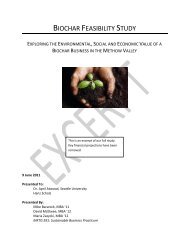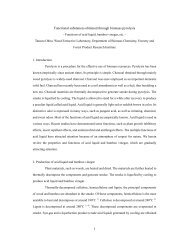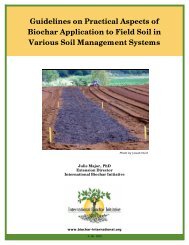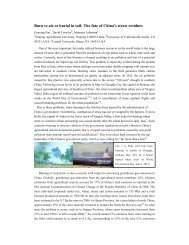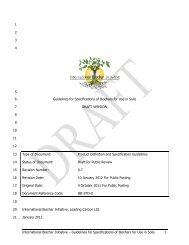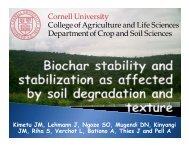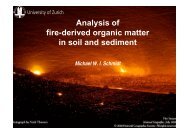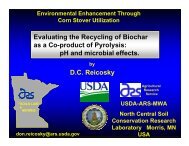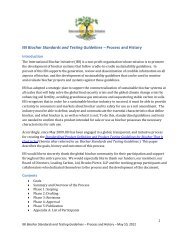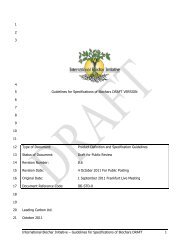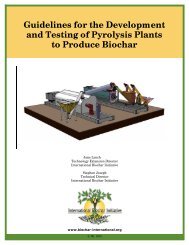ph, Electrical Conductivity Tests - International Biochar Initiative
ph, Electrical Conductivity Tests - International Biochar Initiative
ph, Electrical Conductivity Tests - International Biochar Initiative
You also want an ePaper? Increase the reach of your titles
YUMPU automatically turns print PDFs into web optimized ePapers that Google loves.
Biol Fertil SoilsDOI 10.1007/s00374-011-0624-7ORIGINAL PAPERCorn growth and nitrogen nutrition after additionsof biochars with varying properties to a temperate soilShelby Rajkovich & Akio Enders & Kelly Hanley &Charles Hyland & Andrew R. Zimmerman &Johannes LehmannReceived: 23 May 2011 /Revised: 3 August 2011 /Accepted: 20 September 2011# Springer-Verlag 2011Abstract The effects of biochar properties on crop growthare little understood. Therefore, biochar was produced fromeight feedstocks and pyrolyzed at four temperatures (300°C,400°C, 500°C, 600°C) using slow pyrolysis. Corn was grownfor 46 days in a greenhouse pot trial on a temperate andmoderately fertile Alfisol amended with the biochar atapplication rates of 0.0%, 0.2%, 0.5%, 2.0%, and 7.0% (w/w)(equivalent to 0.0, 2.6, 6.5, 26, and 91 t biochar ha −1 )andfullrecommended fertilization. Animal manure biochars increasedbiomass by up to 43% and corn stover biochar byup to 30%, while food waste biochar decreased biomassby up to 92% in relation to similarly fertilized controls(all P
Biol Fertil Soilsbiochareffectsoncropgrowthintemperatesoilsthatarenot primarily limited by pH or CEC.<strong>Biochar</strong>s can have very different properties dependingon the feedstock they are produced from and the pyrolysisconditions used to generate them (Antal and Grønli 2003;Chan and Xu 2009; Bonelli et al. 2010). The feedstockmainly affects the elemental composition of nutrients andmetals (Chan and Xu 2009), whereas pyrolysis temperaturelargely controls the proportion of volatiles (Zimmerman2010) and surface properties (Amonette and Jose<strong>ph</strong> 2009).Considering the large variation in biochar properties, it isnot surprising that crop yields vary with different biochars(Chen et al. 2010; Gaskin et al. 2010; Makoto et al. 2011).Few studies have been published that compare a wide rangeof well-characterized biochars in their performance withrespect to crop growth (Chan et al. 2008), and none hasbeen reported for temperate soils.In addition to the mentioned beneficial effects on soilproductivity, biochars may also reduce plant growth(Devonald 1982; Gaskin et al. 2010). In some cases, anunfavorably high pH of the biochar in relation to alreadyhigh pH in the studied Calcarosol was identified as thereason for yield depressions (Van Zwieten et al. 2010a). Inother cases, the reason is less clear and may include direct<strong>ph</strong>ytotoxicity possibly of the volatile fraction or negativeeffects of metals (Devonald 1982). Also N immobilizationafter addition of fresh biochar has been observed todecrease N availability (Lehmann et al. 2003b; Bridle andPritchard 2004) which may result in growth depression. Therelationship of biochar chemical and <strong>ph</strong>ysical properties andthese growth-depressing effects have not been systematicallyexamined. Microbiological interactions between rootsand biochar may also occur (Lehmann et al. 2011)which are not investigated further here.To address these knowledge gaps, we investigated theshort-term effects of a large and diverse set of biochars oncorn growth in the greenhouse. The experiments wereconducted with a temperate Alfisol that had no significantfertility constraints. The specific objectives were (a) toquantify the effects of varying biochar characteristics oncorn growth and N uptake, (b) to assess whether feedstockproperties or pyrolysis temperature are more important indetermining initial plant growth, and (c) to identify theoptimum rate of biochar application considering bothpositive and negative effects on growth.Materials and methodsSoil typeThe soil used in this experiment was taken from theCornell Musgrave Research Farm in Aurora, New York,continuously cropped to corn for over 20 years. Thesoil is classified as a Junius loam (0–2% slopes,overtill), Kendaia silt loam (2–5% slopes), and Limaloam (2–6% slopes), or fine-loamy, mixed, mesicGlossoboric Hapludalf. It had a pH of 6.85 in 1 NKCl (ratio of 1:20 w/v), CEC of 97.6 mmol c kg −1 ,claycontent of 27%, total C content of 16.2 mg g −1 ,totalNof1.62 mg g −1 , and Mehlich-3 extractable P of 35.8 mg g −1 ,Kof84.1mgg −1 , Ca of 3,739 mg g −1 ,Mgof483mgg −1 ,andNaof75mgg −1 . The soil was air-dried for severaldays and subsequently shredded using a Royer SoilConditioner to create soil uniformity. Excess organicmaterial was then removed by passing the soil through a5-mm sieve.<strong>Biochar</strong> production<strong>Biochar</strong> was produced from corn stover, hazelnut shells,oak wood, pine wood, digested dairy manure, foodwaste, paper mill waste (sludge), or poultry withsawdust bedding (Table 1). The raw organic materialfor the crop residues and poultry manure was collected inWisconsin; the food waste from Cornell dining facilities;the paper mill waste from Mohawk Paper in Waterford,NY consisting of white, uncolored paper pulp waste; andthe digested dairy manure from AA Farms in Candor, NY(operating with more than 1,000 milking cows). Feedstockwas oven-dried to approximately 10% moisture beforepyrolysis. <strong>Biochar</strong>s were produced using slow pyrolysis(Daisy Reactor, Best Energies, Inc., Cashton, WI, USA).Approximately 3 kg of feedstock was manually placedinto the reactor, which was thoroughly purged with N 2(with the mixer running). The material was charred for80–90 min, including rising temperature to the target witha few degrees per minute and holding at final temperaturefor 15–20 min. Different biochars were generated withtarget temperatures of 300°C, 400°C, 500°C, or 600°C.Subsequently, the furnace was turned off and the mainchamber was allowed to cool before collecting the biocharunder N 2 purge to reduce rapid oxidation (leading to amore homogeneous product) and auto-ignition. In additionto this set of biochars that was produced using theidentical kiln and production procedure (except for thesystematic variation in pyrolysis temperatures), a widerset of biochars was procured from companies and researchgroups which were generated using other thermochemicaltechniques such as torrefaction, fast and flash pyrolysis,and gasification (see Supplementary material for detaileddescription of production conditions). After transportationto the analytical laboratories, biochars were stored dryunder argon gas to limit oxidation on air. All biocharswere ground with a mortar and pestle and passed througha 2-mm sieve just before experimentation.
Biol Fertil SoilsTable 1 Selected <strong>ph</strong>ysical and chemical characteristics of the studied biochars<strong>Biochar</strong> BulkdensitySSA(N2)SSA(CO2)pH(water)EC C N δ 15 N C/N Ash FixedcarbonVolatilematterCEC Ca K Mg Na P Ca K Mg NaMg m −3 m 2 g −1 mS m −1 mg g −1 ‰ % Available(mmol c kg −1 )Total(mg kg −1 )Corn 300°C 0.120 4.7 141 7.33 189 595 11.6 2.29 51 10.70 37.43 51.87 708 105 309 212 2 1,369 6,480 17,052 5,883 492Corn 400°C 0.102 3.9 282 9.17 177 626 11.0 2.13 58 12.90 42.37 44.73 796 55 249 93 3 1,812 7,254 20,234 6,583 904Corn 500°C 0.103 3.2 494 9.92 203 687 11.1 1.76 62 17.60 51.32 31.08 517 54 403 87 4 1,852 11,699 24,817 9,510 1,384Corn 600°C 0.113 3.4 531 9.95 196 698 10.1 2.04 70 16.72 59.80 23.49 385 41 230 53 4 2,114 9,383 24,616 8,582 1,539Hazelnut 300°C 0.336 1.3 224 6.35 38 699 5.4 2.95 159 1.98 49.23 48.79 59 10 5 bd bd 397 3,726 5,166 790 471Hazelnut 400°C 0.411 1.6 493 7.66 14.2 758 5.1 1.88 158 1.69 54.83 43.48 102 11 18 1 1 298 2,821 4,285 554 488Hazelnut 500°C 0.464 3.8 521 8.60 10.6 801 5.1 3.48 177 1.94 60.88 37.19 118 21 41 4 3 275 2,693 4,297 494 447Hazelnut 600°C 0.449 0.9 632 8.85 18.8 841 5.2 3.53 181 2.18 68.19 29.63 56 12 27 2 0 329 3,262 5,162 587 407Oak 300°C 0.264 nd 163 4.25 11.6 639 1.3 bd 520 0.35 38.52 61.13 414 4 6 1 3 6 752 725 46 297Oak 400°C 0.241 3.5 450 4.58 7.6 788 1.7 bd 468 0.78 58.30 40.93 261 6 3 1 3 5 1,061 1,462 61 321Oak 500°C 0.197 1.5 600 5.78 4.8 839 1.8 bd 474 3.72 65.58 30.70 147 5 4 0 3 5 1,538 1,171 57 330Oak 600°C 0.208 0.7 635 6.38 4.8 876 1.7 bd 510 1.31 71.16 27.53 126 7 5 1 3 bd 1,210 2,061 100 52Pine 300°C 0.141 nd 157 6.74 19.2 621 1.0 bd 676 1.48 43.20 55.32 289 19 6 4 3 255 2,927 692 680 327Pine 400°C 0.167 1.4 413 4.57 10.8 744 0.9 bd 900 1.05 53.48 45.47 304 5 3 1 2 35 2,247 373 482 351Pine 500°C 0.138 4.7 524 5.62 4.6 834 1.0 bd 896 1.00 62.05 36.95 240 3 5 1 3 1 2,741 682 796 332Pine 600°C 0.161 1.8 611 5.97 3.8 870 1.3 bd 725 1.07 71.22 27.70 153 4 2 0 2 14 2,167 775 604 320Dairy manure 300°C 0.172 nd nd 8.92 211 561 26.6 8.08 21 39.23 10.29 50.48 444 450 303 316 148 5,391 20,185 14,954 8,757 3,808Dairy manure 400°C 0.169 nd nd 9.22 201 577 24.2 7.85 26 14.50 26.91 58.58 297 393 340 252 151 6,446 22,552 16,604 9,733 4,405Dairy manure 500°C 0.120 nd nd 9.36 217 594 25.8 8.26 23 14.74 42.59 42.67 478 453 330 325 158 3,945 18,505 14,937 8,498 3,861Dairy manure 600°C 0.120 nd nd 9.94 234 628 22.5 6.56 28 18.84 41.73 39.43 151 291 413 164 257 8,269 26,518 20,852 11,744 5,051Food waste 300°C 0.428 nd nd 7.52 465 653 58.8 4.60 11 23.30 31.28 45.42 104 57 307 27 255 5,874 28,177 13,018 3,337 9,852Food waste 400°C 0.500 nd nd 8.27 423 524 36.5 4.06 14 45.96 18.32 35.72 98 157 560 32 413 5,007 51,745 14,557 5,341 9,008Food waste 500°C 0.457 nd nd 9.67 573 367 25.6 4.25 14 52.70 13.59 33.71 88 229 388 37 328 7,524 53,779 21,340 4,461 13,708Food waste 600°C 0.475 nd nd 10.53 645 232 10.3 4.95 23 51.95 13.56 34.48 34 569 110 266 98 8,150 73,534 27,949 6,567 14,503Paper waste 300°C 0.230 nd nd 7.44 71.6 212 0.9 bd 234 50.35 0.00 49.65 83 1,046 0 17 6 827 258,128 2,783 2,428 256Paper waste 400°C 0.269 nd nd 8.18 63 200 1.1 bd 185 54.58 1.23 44.20 62 1,210 5 22 9 830 266,234 3,279 2,831 453Paper waste 500°C 0.315 nd nd 9.28 25.2 192 0.7 bd 258 57.45 0.03 42.52 29 905 1 19 6 818 289,226 3,339 2,739 295Paper waste 600°C 0.352 nd nd 11.14 71.6 192 0.8 bd 250 59.05 0.00 39.95 34 990 bd 20 3 937 311,232 3,848 2,940 370Poultry 300°C 0.520 1.2 55 8.12 495 259 21.5 10.78 13 46.71 6.54 46.76 362 260 422 149 74 26,414 157,531 40,013 8,914 3,868Poultry 400°C 0.631 4.0 47 9.85 333 268 12.4 12.66 46 51.74 4.47 43.79 166 273 299 80 49 17,957 265,729 31,751 7,164 3,209Poultry 500°C 0.549 4.7 88 10.57 419 254 14.1 13.60 18 52.62 4.16 43.22 78 304 379 96 65 30,555 204,205 28,109 10,436 4,537Poultry 600°C 0.646 6.7 93 10.65 377 236 9.4 13.32 28 55.80 0.00 44.20 59 329 316 100 58 23,596 242,788 27,400 8,769 3,457SSA specific surface area, EC electric conductivity, CEC cation exchange capacity, bd below detection, nd not determined
Biol Fertil SoilsExperimental setupA greenhouse experiment was set up using pots with aheight of 360 mm and average diameter of 100 mm(Treepots Short One, Stuewe and Sons, Tangent, OR,USA). Each pot received a uniform volume of 1.65 L ofeither soil or a soil and biochar mixture. Application ratesof biochar included 0.0%, 0.2%, 0.5%, 2.0%, and 7.0% ona dry weight basis (w/w), except for the wider set ofbiochars, which were applied only at a rate of 2%. Thesebiochar application rates correspond to 0.0, 2.6, 6.5, 26, and91 t biochar ha −1 . The amount of biochar required for eachapplication rate was combined with the soil in a V-Mixerfor a minimum of 15 revolutions. The greenhouse at theGuterman Bioclimatic Laboratories, Cornell University,was maintained at temperatures recommended for corngrowth, at 24°C during day and 18°C at night. The potswere randomly positioned on benches. For each biochar,the experiment included two replicate pots of eachapplication rate at each production temperature, and threereplicates for the wider set of biochars. Controls withoutbiochar addition had six replicates. The drainage holes ofthe pots were fitted with fiberglass window mesh to preventsoil loss from irrigation, but pots were otherwise allowed todrain freely. After the soil had been prepared and biocharadded, three seeds (Yieldguard Hybrid treated seed, Dyna-Gro, Loveland, CO, USA) were planted approximately40 mm deep in the center of the pots. At 9 days aftergermination, the two weakest seedlings were culled. Allpots received the same amount of irrigation initiated at thefirst signs of leaf curl to minimize drought stress, with atotal of 24 watering events over the course of the corngrowth. The amount added was adjusted to match or exceedthe water holding capacity and to initiate leaching asdetermined from measurements of field capacity andpreliminary column experiments without plants on allmixtures as well as the control. This procedure wouldminimize effects of biochars on water availability, butmaximize biochar effects on nutrient retention as percolationwould occur.Each pot was given an identical dose of starter fertilizervia fertigation. The recommended treatment for a corn cropwas 10–20–20 (NPK: N as urea, P as diammonium<strong>ph</strong>os<strong>ph</strong>ate, K as muriate of potash) at 123 kg ha −1 , withan application of 12 kg N ha −1 , 10 kg P ha −1 , and10 kg K ha −1 . The fertilizer was ground to pass a #50mesh sieve to ensure uniform application and accurateweighing. The fertilizer was then dissolved into water andadministered via fertigation in three consecutive applicationsof 136 mL per pot to prevent leaching losses duringapplication. All of the pots received an additional applicationof N fertilizer in the form of uncoated granular ureatopdressing (46–0–0) in the amount of 134 kg N ha −1 . Thefertilizer was ground to pass a #50 mesh sieve to ensureuniform application and accurate weighing. The fertilizerwas then dissolved into water and administered viafertigation in one application of 136 mL per pot. Thecontrol pots, which did not receive biochar, received thesame amount of fertilizer and were replicated six times. Nopesticides or herbicides were applied, since no weeds wereexpected and no disease or pest symptoms were visible.Plant samplingThe corn plants were harvested 46 days after planting.The above ground biomass was collected by severing atthe base of the corn stalk. The below ground biomasswas manually separated from the potting soil andwashed off soil and biochar particles. All biomass wasdried to constant weight at 60°C, weighed, and finelyground with a ball mill. A weighted average of aboveand below ground biomass was composited beforechemical analyses.Plant and biochar analyses<strong>Biochar</strong> pH values were obtained in duplicate using a ratioof 1.0 g of biochar in 20 mL deionized water with themodification that the time on the shaker was increased to1.5 h to ensure sufficient equilibration between solution andbiochar surfaces. Electric conductivity (EC) was thendetermined with an Orion model 115A plus conductivitymeter (Thermo Fisher Scientific, Waltham, MA).Biomass N analysis, biochar C and N analyses as well asN isotope determination were performed after samplecombustion to CO 2 and N 2 at 1,000°C in an onlineelemental analyzer (PDZEuropa ANCA-GSL, Crewe, UK)coupled to a continuous flow isotope ratio mass spectrometry(20–20 mass spectrometer, Sercon, Crewe, UK).Nitrogen uptake was calculated by multiplying N concentrationwith biomass production.Potential CEC was determined by saturating 1.0 g of thebiochar with 50 mL of 1 N ammonium acetate at pH 7 andplacing on a shaker table overnight. The shaking ensuredsufficient wetting of the biochar surfaces. After shaking, theinitial 50 mL of 1 N ammonium acetate was extracted byvacuum with an automatic extractor, and a second additionof 40 mL ammonium acetate was added. The samples werethen washed with ethanol three times with a total volume of60 mL and then received 50 mL of 2 N KCl. This initial 50-mL addition of 2 N KCl was allowed to stand 16 h toensure adequate time for replacement of the absorbed NH 4+cations. The initial 50 mL was extracted and thenimmediately followed by a second addition of 40 mL of2 N KCL and subsequent extraction. The extracted NH 4+was quantified using a continuous flow analyzer (Technicon
Biol Fertil SoilsAuto Analyzer, Chauncey, CT, USA). Exchangeable cationsin the biochars were quantified in the ammonium acetateextract by inductively coupled plasma spectro<strong>ph</strong>otometry(ICP-AES, Spectro CIROS, CCD, Germany).Total P, Ca, Mg, K, and Na were obtained after drycombustion by heating to 500°C over 2 h and holding at500°C for 8 h. Five-milliliter HNO 3 were added to eachvessel and digested at 120°C until dryness. Tubes wereremoved from the block and allowed to cool before adding1.0 mL HNO 3 and 4.0 mL H 2 O 2 . Samples were placedback into a preheated block and processed at 120°C todryness, then dissolved with 1.43 mL HNO 3 , made up with18.57 mL deionized water to achieve 5% acid concentration,sonicated for 10 min, and filtered.Bulk density of the biochars was quantified, after sievingto achieve a particle size range of 149–850 μm, by tampingbiochar in a glass cuvette with a diameter of 25 mm and aheight of 70 mm. Specific surface area was assessed usingtwo different methods, BET-N 2 and CO 2 sorption isothermscollected on a Quantachrome Autosorb 1. External surfacearea (pores >1.5 nm) was calculated using multipointadsorption data from the linear segment (in partial pressurerange of 0.001 to 0.03) of the N 2 adsorption isotherms (at77 K) using Brunauer–Emmett–Teller theory. Total surfacearea (including pores
Biol Fertil SoilsHowever, volatile and fixed carbon contents varied to agreater degree with pyrolysis temperature.Biomass productionAcross all biochar types, average total biomass productionwas similar for application rates of 0.2%, 0.5%, and 2%,but significantly lower at 7%. However, there were largedifferences between individual biochars (significant interactionbetween application rate, pyrolysis temperature, andfeedstock; Supplementary Table S1). For our selection ofbiochars, feedstock type had an eight times greater effect oncorn biomass production than pyrolysis temperature (SupplementaryTable S2). Except for large applications (7%),biochar made from corn stover, oak, and pine wood andanimal manures generated positive or no growth responses(Fig. 1). <strong>Biochar</strong> from hazelnut shells did not significantlyaffect growth. At lower pyrolysis temperatures of 300°Cand 400°C, biochar made from food waste and paper millwaste resulted in significant growth reductions. With increasingpyrolysis temperature, however, the negative effects offood and paper mill waste biochars decreased. On average,biochars produced at 500°C had significantly (P
7.02.07.07.07.07.0Biol Fertil SoilsTotal Biomass (g pot -1 )2015105LSD 0.05ControlCornHazelnutOak300 o CTotal Biomass (g pot -1 )2015105Dairy ManureFood WastePaper Mill WastePoultry300 o CControl0Pine2.007.00.50.20.50.2Total Biomass (g pot -1 )20151050CornHazelnutOakPine2.0400 o CTotal Biomass (g pot -1 )201510500.50.2Dairy ManureFood WastePaper Mill WastePoultry2.0400 o C7.00.50.220500 o C20500 o CTotal Biomass (g pot -1 )151050CornHazelnutOakPine2.0Total Biomass (g pot -1 )1510500.50.20.50.2Dairy ManureFood WastePaper Mill WastePoultry2.07.020600 o C20600 o CTotal Biomass (g pot -1 )151050CornHazelnutOakPine2.0Total Biomass (g pot -1 )1510500.50.2<strong>Biochar</strong> Application Rate (%)0.50.2Dairy ManureFood WastePaper Mill WastePoultry2.0Fig. 1 Total biomass production (root and shoot) of corn withdifferent biochars added (symbols) in comparison to the control(dashed horizontal line) without biochar additions (means and<strong>Biochar</strong> Application Rate (%)standard errors; N=2 for biochar-amended soils; N=6 for controlwithout biochar additions; temperature refers to pyrolysis temperature;LSD least significant difference)
Biol Fertil SoilsTable 2 Tissue N concentration of total corn plants grown in soil withdifferent biochars additions (LSD 0.05 =2.55 between feedstocks, 2.64in comparison to control; N=2 for biochar-amended soils; N=6 forcontrol without biochar additions)<strong>Biochar</strong> Tissue N concentrations (mg g −1 )<strong>Biochar</strong> application rates (w/w)0.0% 0.2% 0.5% 2.0% 7.0%Corn 300°C 10.07 9.55 9.68 10.57 8.56Corn 400°C 10.07 9.43 9.57 9.59 8.15Corn 500°C 10.07 10.13 9.85 8.10 8.97Corn 600°C 10.07 8.76 8.47 8.64 8.55Hazelnut 300°C 10.07 11.25 10.12 9.55 10.08Hazelnut 400°C 10.07 9.80 9.95 9.21 8.52Hazelnut 500°C 10.07 11.56 9.71 9.83 9.08Hazelnut 600°C 10.07 9.07 10.21 9.43 8.64Oak 300°C 10.07 9.98 10.32 9.51 9.75Oak 400°C 10.07 10.69 9.69 10.21 10.24Oak 500°C 10.07 11.95 10.30 8.95 9.88Oak 600°C 10.07 9.62 9.26 8.73 8.43Pine 300°C 10.07 10.50 9.56 10.71 10.02Pine 400°C 10.07 10.18 10.85 10.24 9.34Pine 500°C 10.07 9.19 10.08 9.77 10.16Pine 600°C 10.07 10.05 9.78 10.11 9.36Dairy manure 300°C 10.07 10.13 8.93 9.16 9.16Dairy manure 400°C 10.07 9.96 9.59 10.26 8.47Dairy manure 500°C 10.07 8.14 9.27 9.10 9.89Dairy manure 600°C 10.07 8.88 9.59 9.15 8.93Food waste 300°C 10.07 12.03 16.89 13.56 9.37Food waste 400°C 10.07 11.84 9.31 13.45 9.76Food waste 500°C 10.07 14.12 12.62 10.41 9.88Food waste 600°C 10.07 11.25 10.07 9.92 10.56Paper waste 300°C 10.07 9.57 9.72 10.36 9.73Paper waste 400°C 10.07 10.48 10.87 9.65 9.31Paper waste 500°C 10.07 10.53 10.06 9.99 9.20Paper waste 600°C 10.07 10.37 10.47 9.87 9.66Poultry 300°C 10.07 15.99 10.90 11.31 15.21Poultry 400°C 10.07 9.25 10.16 9.26 9.64Poultry 500°C 10.07 10.16 8.65 9.19 9.39Poultry 600°C 10.07 9.68 8.92 8.69 8.68Makoto et al. (2011) for biochar made at 400°C and 800°Cwhich was added to larch seedlings.A comparison of biochars made by a variety oftechnologies, including flash pyrolysis, fast pyrolysis,torrefaction, or gasification (Supplementary Table S8), didnot show a systematic difference that superseded the effectof feedstock (Fig. 4). The nutrient-rich biochars such asthose produced from animal manures or graminaceousplants (switchgrass, corn, rice husks) generally improvedcrop growth over the short period of this experiment,irrespective of production technology (Fig. 4). However,direct comparisons between different pyrolysis technologiesby using identical feedstocks are needed in future studies toavoid biases due to different starting materials. In addition,these results are only valid for corn grown on a relativelyfertile Alfisol under optimal fertilization. Improvements inpH or nutrient retention observed for many other locationswith poorer soils (Lehmann et al. 2003b; Steiner et al.2007; Van Zwieten et al. 2010b) did not have a large effecton crop growth especially at high application rates, asexpected for this experiment. In addition, soil wateravailability was maintained at levels that would minimizegrowth reductions due to water stress, and AWC ofbiochar–soil mixtures did not correlate with plant growth.Therefore, this experiment rather tested what biocharproperties would reduce plant growth under otherwiseoptimum conditions. However, even on the relatively fertileAlfisol investigated here, half of the studied biocharsshowed average growth improvements of 20% at applicationrates of 2.6 and 6.5 t ha −1 compared to a fully fertilizedcontrol without biochar additions.<strong>Biochar</strong> made from plant residues such as hazelnutshells, pine, and oak showed little improvement of therelatively fertile Alfisol, with the exception of biochar fromcorn stover which significantly improved crop growth onaverage by 16% (range between −36% and +32% dependingon pyrolysis temperature and application rates).Pyrolysis of animal manures, food waste, and paper millwaste generated biochars that were either beneficial ordetrimental to crop performance. Similarly, very differentgrowth responses were found for sugar cane grown withbiochar made from either bagasse or biosolids (Chen et al.2010). These results stress the importance of quantifyingyield responses to biochars made from different feedstocksbefore large-scale application.Increasing application rates in our study beyond26 t ha −1 (2%) had either positive, negative, or no effectson corn growth, depending on the biochar. In comparison,Lehmann et al. (2003b) found improved rice growth in anOxisol when application rates of biochar made from woodymaterial was increased from 95 to 180 t ha −1 . Similarly,Chan et al. (2007, 2008) showed increasing crop growthfrom 50 to 100 or 10 to 50 t ha −1 of green waste or poultrymanure biochar added to an acid Alfisol. Rondon et al.(2007) reported improved bean growth in response toincreasing rates of eucalyptus wood biochar from 66 to122 t ha −1 added to a highly weathered savanna soil, butdecreasing growth upon further increases to 188 t ha −1 . Ourresults expand these findings by clearly showing the shorttermgrowth dependency on primarily feedstock type andsecondarily pyrolysis temperature of a wider selection ofbiochars. The responses to increasing rates of biocharapplication may also depend on the crop, which was not
Biol Fertil SoilsN uptake (mg pot -1 )25020015010050CornHazelnutOakPine300 o CLSD 0.05N uptake (mg pot -1 )25020015010050300 o CDairy ManureFood WastePaper Mill WastePoultryControl000.50.20.50.27.02.02.07.0N uptake (mg pot -1 )25020015010050CornHazelnutOakPine400 o CN uptake (mg pot -1 )25020015010050Dairy ManureFood WastePaper Mill WastePoultry400 o C000.50.20.50.22.07.02.07.0N uptake (mg pot -1)25020015010050CornHazelnutOakPine500 o CN uptake (mg -1 )25020015010050Dairy ManureFood WastePaper Mill WastePoultry500 o C000.50.20.50.22.07.02.07.0N uptake (mg pot -1 )25020015010050CornHazelnutOakPine600 o CControlN uptake (mg pot -1 )25020015010050Dairy ManureFood WastePaper Mill WastePoultry600 o C002.07.02.07.00.50.2<strong>Biochar</strong> Application Rate (%)Fig. 2 Total N uptake (root and shoot) of corn with different biocharsadded (symbols) in comparison to the control (dashed horizontal line)without biochar additions (means and standard errors; N=2 for0.50.2<strong>Biochar</strong> Application Rate (%)biochar-amended soils; N=6 for control without biochar additions;temperature refers to pyrolysis temperature; LSD least significantdifference)
Biol Fertil Soils15N (‰)1614121086300 o C400 o C500 o C600 o CDairy manure biochar7.015N (‰)1614121086Poultry manure biocharδ4δ422007.02.00.20.52.00.20.5<strong>Biochar</strong> application rate (%)Fig. 3 Nitrogen stable isotope values (δ 15 N) of the total corn biomassamended with biochar made from either digested dairy manure orpoultry with sawdust at different pyrolysis temperatures in comparisonto the control (dashed line) without biochar additions (means and<strong>Biochar</strong> application rate (%)standard errors; N=2 for biochar-amended soils; N=6 for controlwithout biochar additions; gray area indicate the δ 15 N values of theoriginal biochar) (δ 15 Nof−0.13‰ for the starter and δ 15 N of 4.94‰for the granular topdressing)Table 3 Correlation coefficients (r 2 ) for linear relationships betweenbiochar properties and biomass production or N uptake (N=32; exceptSSA N=20); significant correlations at P0.35;P
Biol Fertil SoilsTotal Biomass (g pot -1 )252015105****** * ***** * * * * ** * *ControlSlow pyrolysisFlash pyrolysisFast pyrolysisUpdraftTorrefactionGasificationActivated carbon**0CornCornCornSoftwoodPoultryPoultrySwitchgrassPoultryMixtureCornPoultryPaperRice huskPeanutMixtureDairyPoultryDairySoybeanGrassDairyHazelnutHazelnutDairyFig. 4 Biomass production (root and shoot) of corn with additions of2% by weight of biochars (26 t ha −1 ) produced using different thermalprocedures in comparison to an unamended control (means andstandard errors; N=2–3 for biochar-amended soils; N=6 for controlwithout biochar additions; ANOVA P
Biol Fertil Soilsbeen observed after additions of biochar and high Napplications (Taghizadeh-Toosi et al. 2011).Even though AWC was in some cases significantlyimproved with biochar additions confirming earlier results(Tryon 1948; Kishimoto and Sugiura 1985; Brockhoff et al.2010), AWC did not correlate with plant growth. This maynot necessarily be explained by a lack of relevant changesin AWC but rather by the way in which the experiment wasdesigned, since watering was done before significant waterstress occurred. Under field or greenhouse conditions wherewater is limiting, the measured differences in AWC may berelevant for plant growth, which warrants further research.<strong>Biochar</strong> characterizationThe most important measured characteristics of biocharsthat allowed prediction of the studied short-term cropperformance on the studied soil were their elementcontents. The nutrient elements such as P, K, or Mgimproved crop growth, whereas Na reduced crop growth.There was no advantage of quantifying available elementcontents (using ammonium acetate extraction) over totalcontents (Table 3). Given the different protocols todetermine plant-available nutrient contents, quantificationof total elemental contents would also be easier tostandardize with appropriate methodology (Enders andLehmann 2011).Quantification of total ash did not succeed as a predictorof short-term corn growth, despite the importance of metalcontents for plant growth in our experiment. The reasonmay be that ash contains both beneficial nutrients as well assalts that are detrimental to plants at high concentrations, asshown here for Na. Therefore, individual elements must bequantified rather than total ash.Neither volatile matter nor fixed carbon contents wererelated to differences in plant growth. However, the short-termnature and the dominance of the nutrient and salt effects in thisexperiment may have obscured the effect of C quality. Thevolatile matter content is expected to relate to the easilymineralizable fraction of biochars (Zimmerman 2010). Yet,the volatile matter did not correlate with crop growth. Thislack of correlation may indicate that volatile matter is notrepresenting the microbially mineralizable fraction of biocharsthat may either cause N immobilization or N inputdepending on its C/N ratios. Either the differences betweenthe biochars were not sufficiently large or the method did notsufficiently capture the proportion that was mineralizable.The relatively wide spread of volatile matter from 23% to61% suggests that indeed a more appropriate method mayneed to be applied to determine the fraction that causesdifferences in N availability.The C/N ratios provided some predictive capacity forreduced N availability (Table 3), even though it wasmeasured on the total biochar, of which the largest fractionis likely stable and does not readily decompose. Total Ncontents proved equally useful to estimate N availability,despite the fact that C contents varied widely (19–87%) andimmobilization depends on relative amounts of C sourcesand N availability.Several biochar properties and their potential effects on cornwere not measured, but may have affected growth. Growthstimulation has been observed through organic substances inthe biochar such as <strong>ph</strong>enols and carboxylic acids or shifts inmicrobial populations toward known growth-promoting microorganisms(Graber et al. 2010). Spokas et al. (2010) showedsignificant production of ethylene that may promote growth asa plant hormone. Disease resistance was greater with biocharadditions to soil (Elad et al. 2010; Elmer and Pignatello 2011).It cannot be excluded that these mechanisms played a role, butwere not captured in our study.<strong>Biochar</strong> optimizationTo optimize crop responses in the short term, nutrient andsalt contents in the biochar must be managed such as P, K,Mg, or Na. For the studied biochar, soil, and crop type,there are two options for addressing the negative effects ofNa on plant growth: (a) to limit the total Na concentrationin the biochar to values around 5,000 mg kg −1 or (b) tolimit the application rate to between 0.5% and 2% (6.5–26 t ha −1 ) (Supplementary Fig. S2). Options not studiedhere also include post-treatment of the biochars such asrinsing that would reduce Na loadings or application at atime of year that would ensure leaching of Na by rainfallbefore a crop is planted, with the caveat that beneficialnutrients are leached, as well. Blending of differentbiochars and judicious dosing may be the preferred strategyto avoid the need for post-treatment, minimize nutrientleaching, and maximize resource use efficiency.In addition, N deficiency may need to be addressed.Higher pyrolysis temperatures of 500–600°C may minimizeN immobilization, as the mineralizable fraction of thebiochar decreases. Post-treatment to remove mineralizableC from biochars with high C/N ratios may be achievableand should be tested more rigorously. However, effects oftreatments such as steam activation on other nutrients haveto be considered. Chan et al. (2008) found lower N useefficiency of steam-treated poultry manure biochar made at550°C compared to untreated biochar made at 450°C,which the authors explained by lower available P contentsthrough steam treatment. In addition to changes in biocharproduction conditions, also the cropping system can beadapted to such initially lower N availability after biocharaddition by choosing legume crops that fix atmos<strong>ph</strong>eric Nand where biological N 2 fixation may even be stimulatedby lower N availability (Rondon et al. 2007).
Biol Fertil SoilsConclusionsThe short-term data shown here apply primarily to thestudied biochars and corn crop under the specific soilconditions. The conclusions are not necessarily applicableto field settings, since, for example, Na may have beenleached from the studied soil under the temperate climateconditions that it occurs in during early-season rains, andnot caused growth depression as shown in the greenhouseexperiment with initially little leaching. However, they aredirectly relevant to horticultural applications that utilizepots and have to be considered for short-term responseseven under field conditions.In addition to biochar properties, growth responses willvary on different soils and with different crops. Thecomplexity of possible interactions between crop, soil,and biochar may be very large, as evident from the presentexperiment with only one crop and one soil. Decision toolsneed to be developed that capture this complexity andshould be continuously refined.Post-treatment of biochars may provide useful opportunitiesto alleviate possible negative effects on crop growthas shown here for Na. In addition, the long-term effect ofbiochars that may become oxidized in soils over time andfrom which minerals have been leached should beexamined across a similarly wide range of feedstocks andproduction conditions as in the present study.Acknowledgments We appreciate the support by the CornellPresidential Scholarship to S.R., by the New York State EnergyResearch and Development Authority (NYSERDA Agreement 9891),by the USDA Hatch grant, and partial support by the National ScienceFoundation’s Basic Research for Enabling Agricultural Development(NSF-BREAD grant number IOS-0965336). Any opinions, findings,and conclusions or recommendations expressed in this material arethose of the authors and do not necessarily reflect the views of thedonors. We thank Elena Miller-ter-Kuile for the help in conducting theexperiment; several individuals who allowed us to conduct experimentswith their biochars, specifically Michael Antal, BEST Energies,Akwasi Boateng, Sergio Capareda, Chee Chia, Dynamotive, BobHawkins, Ste<strong>ph</strong>en Jose<strong>ph</strong>, and Jerome Matthews; and severalanonymous referees for their valuable comments.ReferencesAmonette JE, Jose<strong>ph</strong> S (2009) Characteristics of biochar: microchemicalproperties. In: Lehmann J, Jose<strong>ph</strong> S (eds) <strong>Biochar</strong> forenvironmental management. Earthscan, London, pp 33–52Antal MJ, Grønli M (2003) The art, science, and technology ofcharcoal production. Ind Eng Chem Res 42:1619–1640Bonelli PR, Della Rocca PA, Cerrella EG, Cukierman AL (2010) Effectof pyrolysis temperature on composition, surface properties andthermal degradation rates of Brazil Nut shells. Biores Technol76:15–22Bridle TR, Pritchard D (2004) Energy and nutrient recovery fromsewage sludge via pyrolysis. Water Sci Technol 50:169–175Brockhoff SR, Christians NE, Killorn RJ, Horton R, Davis DD (2010)Physical and mineral-nutrition properties of sand-based turfgrassroot zones amended with biochar. Agron J 102:1627–1631Chan KY, Xu Z (2009) <strong>Biochar</strong>: nutrient properties and theirenhancement. In: Lehmann J, Jose<strong>ph</strong> S (eds) <strong>Biochar</strong> forenvironmental management. Earthscan, London, pp 67–84Chan KY, Van Zwieten L, Meszaros I, Downie A, Jose<strong>ph</strong> S (2007)Agronomic values of greenwaste biochar as a soil amendment.Austr J Soil Res 45:629–634Chan KY, Van Zwieten L, Meszaros I, Downie A, Jose<strong>ph</strong> S (2008)Using poultry litter biochars as soil amendments. Austr J SoilRes 46:437–444Chen Y, Shinogi Y, Taira M (2010) Influence of biochar use onsugarcane growth, soil parameters, and groundwater quality.Austr J Soil Res 48:526–530Devonald VG (1982) The effect of wood charcoal on the growth andnodulation of garden peas in pot culture. Plant Soil 66:125–127Elad Y, Rav David D, Meller Harel Y, Borenshtein M, Ben Kalifa H,Silber A, Graber ER (2010) Induction of systemic resistance inplants by biochar, a soil-applied carbon sequestering agent.Phytopathology 100:913–921Elmer WH, Pignatello JJ (2011) Effect of biochar amendments onmycorrhizal associations and Fusarium crown and root rot ofasparagus in replant soils. Plant Dis 95:960–966Enders A, Lehmann J (2011) Comparison of wet digestion and dryashing methods for total elemental analysis of biochar. CommSoil Sci Plant Anal (in press)Fortmeier R, Schubert S (1995) Salt tolerance of maize (Zea mays L.):the role of sodium exclusion. Plant Cell Env 18:1041–1047Gaskin JW, Speir RA, Harris K, Das KC, Lee RD, Morris LA,Fisher DS (2010) Effect of peanut hull and pine chip biocharon soil nutrients, corn nutrient status, and yield. Agron J102:623–633Graber ER, Harel YM, Kolton M, Cytryn E, Silber A, David DR,Tsechansky L, Borenshtein M, Elad Y (2010) <strong>Biochar</strong> impact ondevelopment and productivity of pepper and tomato grown infertigated soilless media. Plant Soil 337:481–496Hidetoshi A, Benjamin SK, Haefele SM, Songyikhangsuthor K,Homma K, Kiyono Y, Inoue Y, Shiraiwa T, Horie T (2009)<strong>Biochar</strong> amendment techniques for upland rice production inNorthern Laos 1. Soil <strong>ph</strong>ysical properties, leaf SPAD and grainyield. Field Crops Res 111:81–84Kimetu J, Lehmann J, Ngoze S, Mugendi D, Kinyangi J, Riha S,Verchot L, Recha J, Pell A (2008) Reversibility of soilproductivity decline with organic matter of differing qualityalong a degradation gradient. Ecosystems 11:726–739Kishimoto S, Sugiura G (1985) Charcoal as a soil conditioner. In:Symposium on Forest Products Research, <strong>International</strong> Achievementsfor the Future, vol 5, pp 12/23/1-12/23/15Kuzyakov Y, Subbotina I, Chen H, Bogomolova I, Xu X (2009) Blackcarbon decomposition and incorporation into microbial biomassestimated by 14C labeling. Soil Biol Biochem 41:210–219Lehmann J, Kern DC, German LA, McCann J, Martins GC, MoreiraA (2003a) Soil fertility and production potential. In: Lehmann J,Kern DC, Glaser B, Woods WI (eds) Amazonian dark earths:origin, properties management. Kluwer Academic, Dordrecht, pp105–124Lehmann J, da Silva Jr JP, Steiner C, Nehls T, Zech W, Glaser B(2003b) Nutrient availability and leaching in an archaeologicalAnthrosol and a Ferralsol of the Central Amazon basin: fertilizer,manure and charcoal amendments. Plant Soil 249:343–357Lehmann J, Amonette JE, Roberts K (2010) Role of biochar inmitigation of climate change. In: Hillel D, Rosenzweig C (eds)Handbook of climate change and agroecosystems: impacts,adaptation, and mitigation. Imperial College Press, London, pp343–363
Biol Fertil SoilsLehmann J, Rillig M, Thies J, Masiello CA, Hockaday WC, CrowleyD (2011) <strong>Biochar</strong> effects on soil biota—a review. Soil BiolBiochem 43:1812–1836Liang B, Lehmann J, Solomon D, Kinyangi J, Grossman J, O’Neill B,Skjemstad JO, Thies J, Luizão FJ, Petersen J, Neves EG (2006)Black carbon increases cation exchange capacity in soils. Soil SciSoc Am J 70:1719–1730Major J, Rondon M, Molina D, Riha S, Lehmann J (2010) Maize yieldand nutrition during 4 years after biochar application to aColombian savanna oxisol. Plant Soil 333:117–128Makoto K, Choi D, Hashidoko Y, Koike T (2011) The growth of Larixgmelinii seedlings as affected by charcoal produced at twodifferent temperatures. Biol Fert Soils 47:467–472Nguyen B, Lehmann J, Hockaday WC, Jose<strong>ph</strong> S, Masiello CA (2010)Temperature sensitivity of black carbon decomposition andoxidation. Environ Sci Technol 44:3324–3331Nieder R, Benbi DK, Scherer HW (2011) Fixation and defixation ofammonium in soils: a review. Biol Fert Soils 47:1–14Parton W, Silver WL, Burke IC, Grassens L, Harmon ME, Currie WS,King JY, Adair EC, Brandt LA, Hart SC, Fasth B (2007) Globalscalesimilarities in nitrogen release patterns during long-termdecomposition. Science 315:361–364Rondon M, Lehmann J, Ramírez J, Hurtado M (2007) Biologicalnitrogen fixation by common beans (Phaseolus vulgaris L.)increases with bio-char additions. Biol Fert Soils 43:699–708Spokas KA, Baker JM, Reicosky DC (2010) Ethylene: potential keyfor biochar amendment impacts. Plant Soil 333:443–452Steiner C, Teixeira WG, Lehmann J, Nehls T, de Macedo JLV, BlumWEH, Zech W (2007) Long term effects of manure, charcoal andmineral fertilization on crop production and fertility on a highlyweathered central Amazonian upland soil. Plant Soil 291:275–290Steiner C, Glaser B, Teixeira WG, Lehmann J, Blum WEH, Zech W(2008a) Nitrogen retention and plant uptake on a highlyweathered central Amazonian Ferralsol amended with compostand charcoal. J Plant Nutr Soil Sci 171:893–899Steiner C, Das KC, Garcia M, Förster B, Zech W (2008b) Charcoaland smoke extract stimulate the soil microbial community in ahighly weathered xanthic Ferralsol. Pedobiologia 51:359–366Taghizadeh-Toosi A, Clough TJ, Condron LM, Sherlock RR,Anderson CR, Craigie RA (2011) <strong>Biochar</strong> incorporation intopasture soil suppresses in situ nitrous oxide emissions fromruminant urine patches. J Environ Qual 40:468–476Tryon EH (1948) Effect of charcoal on certain <strong>ph</strong>ysical, chemical, andbiological properties of forest soils. Ecol Monogr 18:81–115USDA (1965) Soil Survey—Tompkins County. United States Departmentof Agriculture, Soil Conservation Service, Washington, DCVan Zwieten L, Kimber S, Morris S, Chan KY, Downie A, Rust J,Jose<strong>ph</strong> S, Cowie A (2010a) Effects of biochar from slowpyrolysis of papermill waste on agronomic performance and soilfertility. Plant Soil 327:235–246Van Zwieten L, Kimber S, Downie A, Morris S, Petty S, Rust J, ChanKY (2010b) A glasshouse study on the interaction of low mineralash biochar with nitrogen in a sandy soil. Austr J Soil Res48:569–576Yamato M, Okimori Y, Wibowo IF, Anshori S, Ogawa M (2006)Effects of the application of charred bark of Acacia mangium onthe yield of maize, cowpea and peanut, and soil chemicalproperties in South Sumatra, Indonesia. Soil Sci Plant Nutr52:489–495Yeboah E, Ofori P, Quansah GW, Dugan E, Sohi SP (2009) Improvingsoil productivity through biochar amendments to soils. Afr J EnvSci Technol 3:34–41Yuan J-H, Xu R-K (2011) The amelioration effects of low temperaturebiochar generated from nine crop residues on an acidic Ultisol.Soil Use Manag 27:110–115Zimmerman A (2010) Abiotic and microbial oxidation of laboratoryproducedblack carbon (biochar). Env Sci Tech 44:1295–1301



